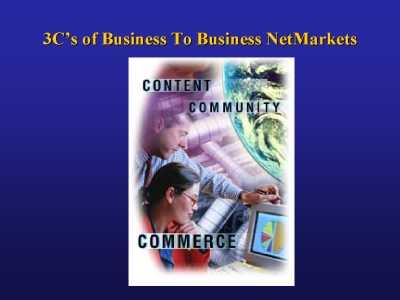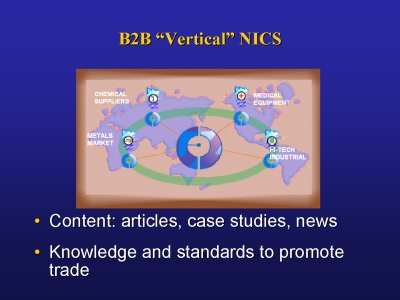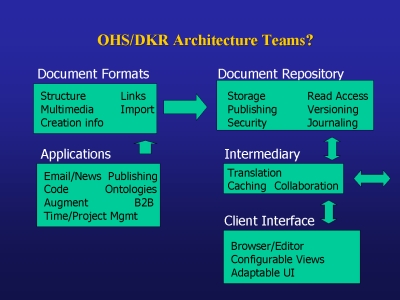OHS/DKR for B2B NetMarkets Adam Cheyer. 1.* - unedited transcript - First I would like to say I'm a little guilty that Doug rushed through just to get to us. I think it is an honor. I'm going to keep this really brief. There are basically three things I want to accomplish at this talk. The first is Douglas talking about increased participations. We have been watching why this approach and this technology and methodology can do things like solve world problems and all of that, but in today's community when people are pouring billions of dollars into the Silicon Valley I thought I'd spend a few minutes to make a business case to why this could fit into something called business to business e-commerce markets where there is really a lot of money going into so that you can go back to your friends that are in B to B startup companies and say this is what you should be doing. The second thing I would like to do is a very brief proposal about how do we organize a little bit to move forward into subgroups or teams, around the, I'm coming from a technology perspective here, and you will see a little bit of that. And my third objective is to introduce some of the other people who are going to be speaking after me by giving their views on what applications we should be addressing. Perhaps what technological approach we should be taking for moving forward. I'm now working as Douglas said at a business-to-business commerce company as director of advanced products and research. What is business-to-business e-commerce? So basically it's like commerce for consumers, like e-bay and Amazon and these small companies like this, but someone realized that businesses spend a thousand times more money per year selling to each other than selling to consumers. So this is a really good space to get in there. Why does what Doug is doing and Bootstrap Institute is doing have anything to do with business-to-business commerce?
Basically any of the commerce companies, any of the companies in this space say there are really 3C's that have to be addressed. These are content, community, and commerce. I think already the content and community aspects Doug already directly addressed and the commerce aspect rely on the content and the community and we will see a little bit of this later on. A few things sort of struck me during Doug's talk today. He was saying every technology company is moving out and here is the anticipatable future, and I realize that since joining an internet company that internet, with internet time two years is beyond what anyone can see in this space. Six months from now, we can maybe imagine what will be there, but two years is forever, so all of these things about technology are going to be dramatically pushing the limits of what we, how we need to integrate technology but even things such as e-commerce are going to dramatically improve. So we need to have capabilities that can address these problems. Another thing Doug was talking about was global scale. Why can't government organize to do these types of cases, and maybe states and at different levels? Verticom, the company I work for, the basic idea is to organize online communities around different industries that will allow trading in this particular space. One of our communities happens to be the state of Maryland, who are trying to, there are actually a lot of knowledge, content, community and commerce that goes on by the state. We should organize as a community in a business-to-business space. So there is direct relevance with some of these topics.
This may be a little difficult to read but basically in business to business commerce there are net markets forming around different communities or vertical industries, and you can think of them in Doug's terms as NICS, so we have companies or group of companies who are really interested in medals marketplaces, and others chemicals and medical equipment and high tech. For all of these communities or trading communities, they need content being brought in such as articles, case studies, news, so enabling tools that allow participants to come together and start sharing information is really important for creating a successful B2B enterprise today. So the B2B people should really be looking at these types of techniques. Additionally knowledge and standards are going to be the things that drive e-commerce. If you are going to have companies that are going to share information and exchange information, that's not a very simple problem. Standards such as XML have begun to address this, however you still need to have the vocabulary and processes that are going to form that will leverage XML, but will enable the exchange. So creating dynamic environments where people can co-actively produce the standards and comment on them and discuss them, very important if you are getting successful B2B commerce. So these are just two quick slides on why dynamic knowledge repositories open hyper duct systems are critical for success in the B2B space. My third and final slide is a little bit organized in a technical sense, but here is an architecture where we are going to if we had this wonderful OHS, it's going to be driven by a number of applications. The requirement of these applications, such as B2B here will say I need to produce this type of information and exchange this type of information will inform the rest of the process. We are going to see some talks from other people coming after me about what should we be doing first with our OHS system. I want to say that I agree with the bootstrapping idea of Doug's approach so, the things that we are using to actually produce, to improve what we are doing are the things we should do first. So for instance, the way that we communicate with e-mail and news that may be a very good candidate. The code that we develop, if we could develop better tools to develop the code we could develop the code faster. What I mean by augment is learning. What Doug has here is a particular set of documents and a system. If we can inform people, or find a way to inform people better personally as to what this system has as capabilities that will enable more people to get excited about these types of techniques and help move forward. So we will have a number of applications and I propose that we organize a set of teams around what those applications should be and what are the requirements that will move forward.
Based on the applications this will determine what types of knowledge or documents do we need to produce. Is video going to be important and should it be a high priority? What type of linking will enable our applications? Do we need back links to really further particular discussions or indirect links for different pieces? What type of formats do we need to be able to convert and input, such as the one list being converted into hyper mail. Once we have sort of document format to process we need to figure out how do we store it and what capabilities do we need to manage these documents in terms of security, versioning, and journaling. We can't do everything. We need to start prioritizing. I of course have my particular opinions about which applications, and formats and technologies should be developed, but these are sort of teams that will need to interact to provide consensus on where to move. Intermediary, so Doug gave a few words on how things like WBI can really enable capabilities in an OHS space. Finally, how do we build, what is the client interface look like, and do we just use a standard browser or do we go build our own web browser. There's a range of possibilities, and we really need to, there is actually a missing arrow here because what we can do here, applications will feedback into this need as well. So the proposal here is a generic one. Lets try to organize into teams and topics to discuss these interfaces, and actually start moving forward on an appropriate path. So the speakers that follow me will be discussing either somewhere in applications and documents, or some technology approaches to be using, and hopefully that will be a service and introduction as to what follows next. Thank you.
---
Above space serves to put hyperlinked
targets at the top of the window
|

 Fig. 1
Fig. 1 Fig. 2
Fig. 2 Fig. 3
Fig. 3